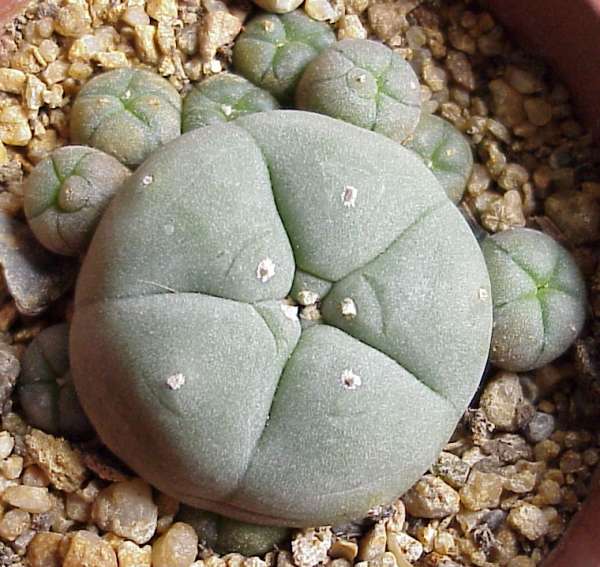Lophophora is a genus of spineless, button-like cacti native to the southwestern United States (Texas and New Mexico) through Northeast Mexico and South to Querétaro.
Literally, Lophophora means "crest-bearing", referring to the tufts of trichomes that adorn each tubercle. The name is derived from the two Greek words λοφος (lophos, the crest of a hill or helmet) and φορεω (phoreo, to carry).
The species are extremely slow growing, sometimes taking up to thirty years to reach flowering age (at the size of about a golf ball, not including the root) in the wild. So the planter should be very patient. However, cultivated specimens grow considerably faster, usually taking between three to ten years to reach from seedling to mature flowering adult. Due to this slow growth and over-harvesting by collectors, the species are considered to be in danger of extinction in the wild.
Lophophora has been reported to be comprised of everything from one species, L. williamsii with varieties, to the four species L. diffusa, L. fricii, L. viridescens, and L. williamsii. Most modern authorities consider Lophophora to be a genus of two species, L. diffusa and L. williamsii. Recent DNA sequencing studies have shown that L. diffusa and L. williamsii indeed are distinct species. DNA evidence from the alleged species L. fricii and L. viridescens would allow for more accurate classification.
Pest
Lophophora suffer from mealy bugs and worse of all red spider mites. Red spider mite can disfigure a soft skinned plant like a Lophophora in a matter of days, it is then disfigured for a few years until you can grow out the marked skin. The red spider mites are tiny and almost invisible to the naked eye but you will see the fine webs across the surface of the plants.
There is no doubt that prevention is better than cure and our plants are sprayed routinely with Spider Mite Control and Buzz Off. These are organic products and are not absorbed into the plants epidermis. Another pesticide
Lophophora can take a lot of watering growing in this soil mix, rainwater is best but tap water is also fine. According to the experience of writer who lives in UK, his plants were out with no protection from April until October 2005 with the soil wet almost every day of the season. The result: healthy fat plants with a much better colouring than those grown in the glasshouses and with no pests.The plants were fed with a 12.5-25-25 fertilizer, every two - three weeks.
Source: wikipedia and www.divinecactus.com

No comments:
Post a Comment